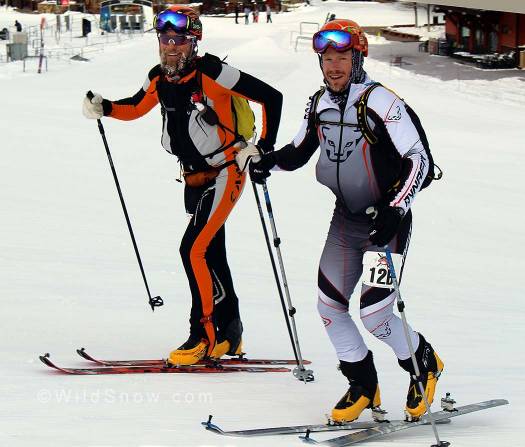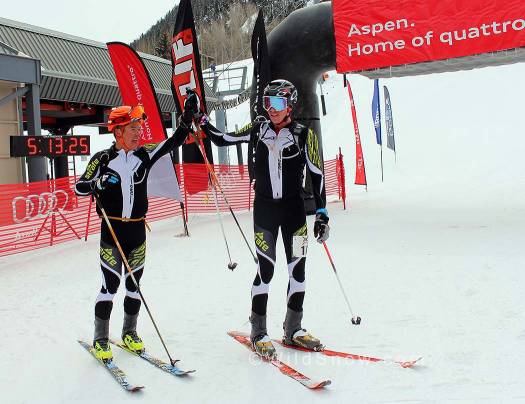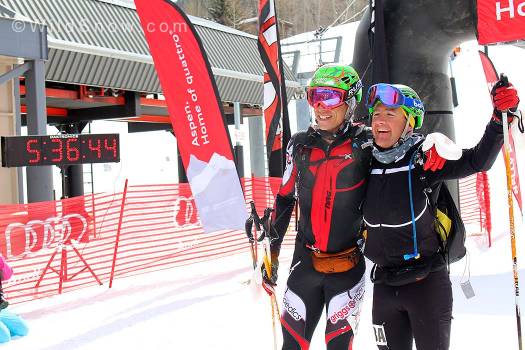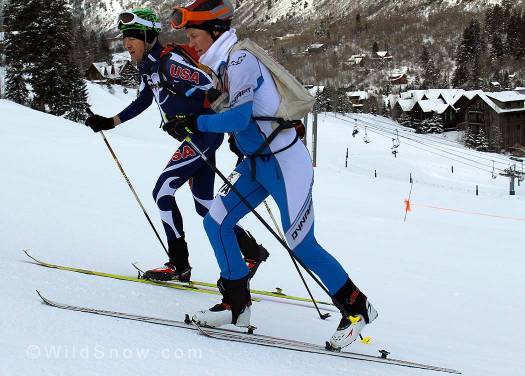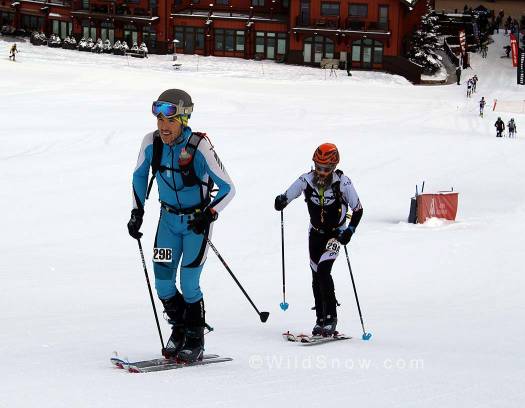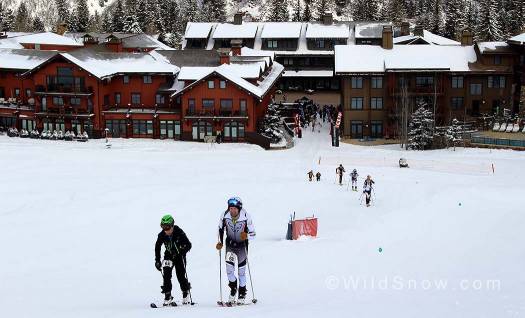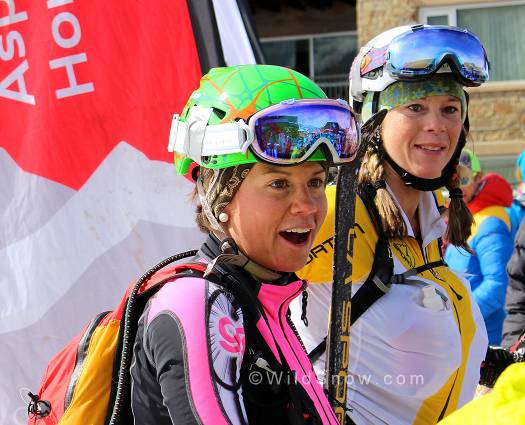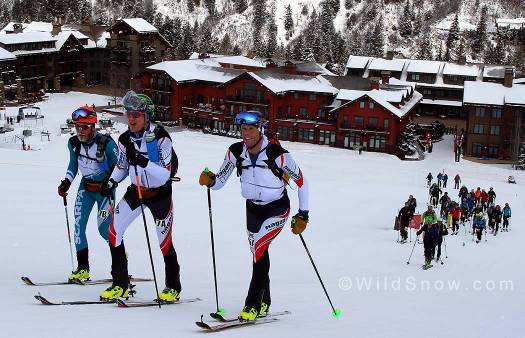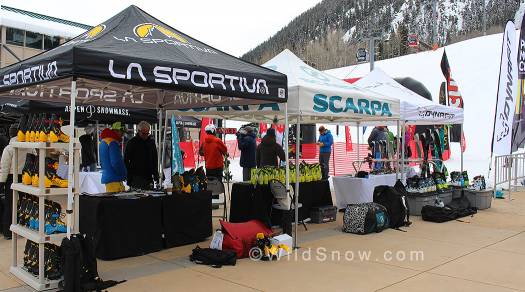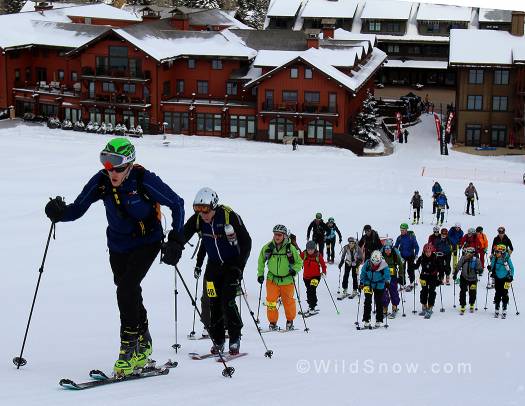“If I learned one thing in the 10th Mountain Division,” said an old soldier I once met, “It’s to never ski uphill again.”
That particular WWII vet* passed a few years ago, but he did live to see backcountry skiing gear evolve from what soldiers in 1942 called “torture boards,” to svelte ski-boot-binding combinations that weigh little more than a heavy pair of hiking boots. In fact, I recall that old fighter did get out on light touring gear and enjoy a few 10th Mountain huts in his golden years.
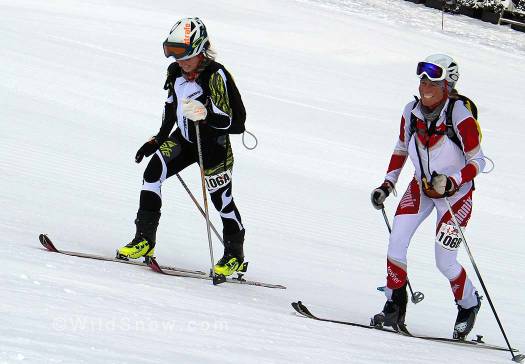
Jessie Young and Anne Gonzales charging up Highlands on their way to women’s sport division second place with a time of 6:07.
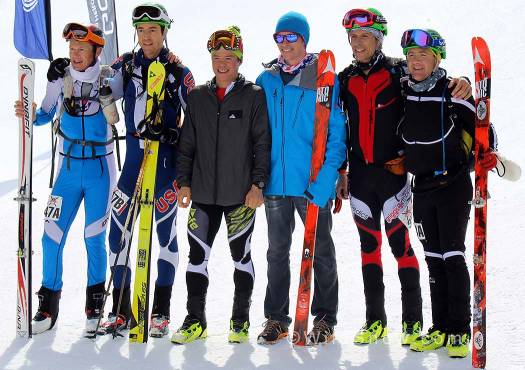
Top three men’s sport teams: Pete Swenson, Rory Kelly (5:37), Max Taam, John Gaston (5:13), William Laird, Jon Brown (5:36).
So what is it about human nature? We figure out how to make backcountry skiing relatively painless, and a bunch of fanatics go out and cause themselves so much pain that Obama might have to give a speech about it? It’s not pain, it’s “pure bliss,” according to participants in Audi Power of Four skimo race. At least that’s what they told me at the start. Watching them at the finish told me they’d possibly lied though some were doing a pretty good job of hiding the torment.
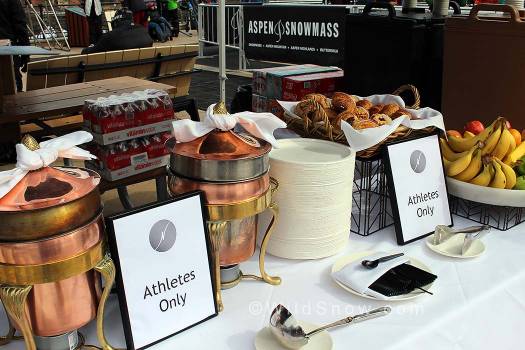
They served well deserved goodies for the athletes but they forgot about the cowbells and Gluhwein for the spectators. They did catch His Blogness sneaking a pastry. “But, I’m a ski journalist!” he was heard shouting as they hauled him to the Pitkin County slammer (where they do serve coffee and croissant every morning, or so we’ve heard.)
Audi Power of Four skimo race (P4) connects all four of the “Aspen” ski resorts by using connector routes involving everything from nearly impossible tree skiing, to running on pavement in your ski boots. Between those little adventures you climb almost 12,000 vertical feet (3,600 meters) at altitudes up to 12,382 ft (3,774 meters). Horizontal distance traveled is about 25 miles.
(Note that a “recreational” course is raced as well, with less vertical and distance but still challenging.)
What I love about P4 (besides seeing athletic excellence) is how readily this tournament displays the evolution of skimo racing in North America. The sport was well developed in Europe many years ago, but caught on slowly in the New World. As recently as 15 or so years ago, “real” skimo racing in North America (defined by having significant downhill skiing as well as uphill) was inaugurated by races such as the Powder Keg in Utah and a “rally” at Whistler. While a few serious competitors raced in those contests, the field was overall quite mixed. Participants experimented with everything from full-on nordic x-c race gear to “heavy metal” setups that mimicked the weight of alpine gear (I’ll win it on the downhill!). Few in North America realized that skimo racing had more in common with bicycle racing than it did with alpine ski racing. Change came quickly.
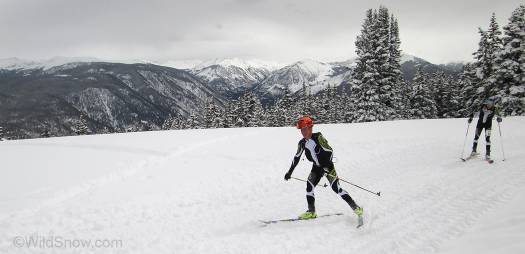
John Gaston (right) and Max Taam at the last high point in Audi Power of 4 skimo race on Richmond Ridge looking east at the Independence Pass region of Colorado.
Watching the latest Audi Power of Four, I was struck by how specialized the gear had become, and how many of the 200 or so participants were using it. More, the atmosphere was ever more about “fit and fast.” Still more casual and friendly than top races in Europe, but nice to see the pursuit of excellence. After all, it’s a race not a ski tour.
If you’re reading this website you are probably a seasoned backcountry skier and know how wonderful ski touring gear has become. But you might not realize that skimo race equipment has undergone an amazing evolution as well. The races are often won on the downhills since the top athletes have similar cardio, so the skis not only have to be competitively light, but they’re designed to slash at speeds around 60 mph as well as survive double-black terrain (now you know why they require helmets). The boots keep getting lighter, with an almost “running shoe” feel in walk mode, but they ski down as well. The boot technology in particular has cross pollinated to normal ski touring gear, perhaps the biggest reason we have such well articulating backcountry ski boots.
And the binding, oh, the binding. The tech binding revolution was driven in the beginning by racing (specifically, the Italian race scene). While many more tech bindings are now sold for regular ski touring, all race bindings are still based on the classic tech binding design, only they’re so light and simple you’d think it was science fiction.
Enough gear talk. What makes these races so cool, so fun to watch, are the athletes. Unlike perhaps any other ski racing discipline, skimo requires a combination of downhill skill and uphill cardio that defies belief. To keep themselves honest (and having “fun”) the racers demand courses that challenge on both levels. Power of Four, for example, sends every racer down double-black diamond terrain and even hits a sidecountry area with sparse snow and trees so dense the racers would probably be better of jogging down the hill — only in that section they’re required to ski.
Adding to the skill set, longer races such as this require intelligent feeding and pacing. Intellectual challenges in contrast to the pure gut you can get away with in shorter contests.
Knowing all this, spectate one of these infernos and you’re sure to enjoy. Only way to top that is do a few races yourself! Which is entirely possible. If you’ve got a modicum of ski skill and cardio fitness, you can find plenty of “recreational” ski mountaineering races around the country. In some places you can even rent or “demo” light enough gear to allow enjoyable participation.
Which brings me to the other component of this weekend’s festivities. As claimed by Aspen’s mayor Steve Skadron, Aspen is an epicenter of uphill skiing in North America.
I’m fond of joking about Skadron’s take, as most of the areas where uphilling is practiced around here are actually NOT in or even adjacent to the village of Aspen. But Aspenites are indeed fond of claiming anything nearby as “Aspen’s” so we’ll take that point of view (for example, we live 30 miles away in Carbondale, where you’ll find what Steve would probably call “Aspen’s only dedicated uphill skiing shop, Cripple Creek Backcountry.)
Joking aside, the greater Aspen area and the core village all have a deep history of ski mountaineering going back to the 1940s and 10th Mountain Division days. As early as the 1960s and 1970s, a number of Aspen locals (myself included) made a habit of uphilling at the resorts as training for mountaineering. The most famous of the Aspen uphillers was a German guy named Fritz Stammberger, who skied uphill with a pack full of stones to simulate the load he’d carry in the Himalayas.
So Steve does have a case. In conjunction with the P4 race, at the behest of Aspen’s mayor the city sponsored an “uphill festival” that was kind of a nascent version of other festivals held around our continent (e.g., Vertfest).
How exciting, another village of equipment tents and demo gear?
The difference is Steve has a vision for uphill skiing being integrated into the commercial fabric of our area. I’m not sure how much that can happen in terms of the industrial component (you’re not going to find a cheap warehouse in the Aspen valley). In the athletic sense, however, we could indeed become a center for uphilling. As many of you know, I’m not exactly an amature when it comes to the ski touring and uphilling industry around the world. From direct experience over the past eight years I know what works. So here is the list for Mister Skadron, with some critique thrown in.
1. Provide uphill routes at resorts. This is already a reality but needs a few adjustments. Many ski patrol I’ve spoken with seem to look at uphillers as a nuisance rather than legitimate resort guests. As a result, the uphill routes are boring grunts that bypass potentially interesting options. For example, at one resort the uphill route passes by a beautiful aspen forest where a “nature trail” single track could be set that avoided the piste and gave a super aesthetic experience.
2. Open a restaurant Friday and Saturday evening at the top of an uphill route. Doing this is so successful in Europe that it’s hard to exaggerate. One restaurant I uphilled to, at night, served 1,800 plates. Several restaurants on the Aspen ski mountains would work for this. Snowmass is too far removed for valley residents, but the Cliff House on Buttermilk is ideal.
3. Parking and swift public transportation are key. Currently our transportation network is less than ideal for uphillers, but the potential is there. Like it or not, automobiles are still the best way to access a quick uphill workout unless you live near the base of a resort. Instead of “disincentives” that just make it harder and more expensive to drive, we’d rather see a positive effort to improve public transport. (And the realization that cars are here to stay for the foreseeable future.)
4. While lip service to creating a “center of uphilling” is all well and good, we need buy-in from the Aspen Skiing Company. As they’ve done in Crested Butte, the resorts must somehow monetize uphilling. In my view the ideal is to consider uphillers as restaurant business and leave it at that. But an inexpensive “uphilling” ticket or season pass is not a far fetched idea (though charging money seems like a cop out compared to keeping it free and counting on the eateries getting business).
5. Mayor Steve and his cohorts need to acknowledge that the worldwide centers for uphill skiing exist in Europe. If Steve has not done so already, he should spend a few weeks traveling and uphilling the Alps. I’d suggest two destinations: Bormio Italy, contact Ski Trab, and the Innsbruck/Kitzbuhel area of the Tirol where he can check out a massive uphilling scene that draws on the large population of the Inn Valley. February would be a good month for the visit. Usually it’s cold enough to keep the resort uphilling routes intact, but enough snow by then for the classic ski tours in the Tirol. I’ll be happy to hire on as a travel consultant.
To learn more about ski mountaineering racing in the U.S., check out the United States Ski Mountaineering Association website.
(*My recollection is Vail co-founder Bob Parker said this when I met him at a 10th Mountain Division reunion many years ago, but it could have been one of his fellow vets.)
Audi Power of Four hero shots:
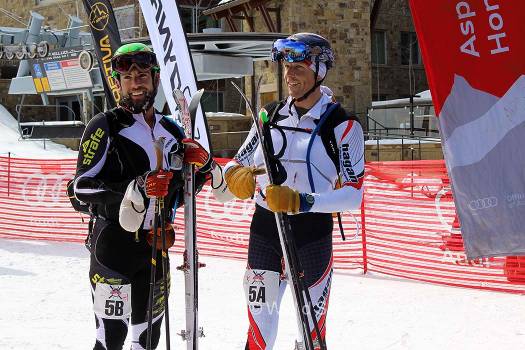
Cripple Creek Backcountry co-owner Doug Stenclik and partner Brian Edmiston finishing in the top ten (6:34).
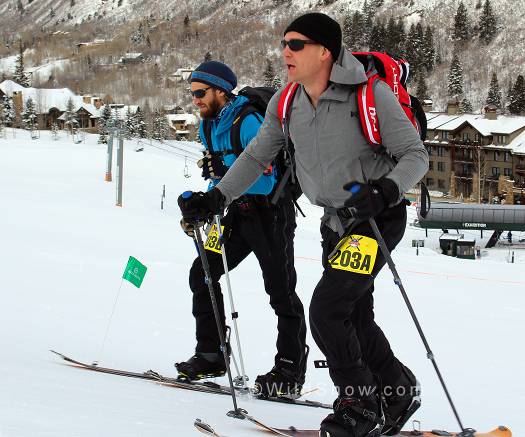
Splitboard team Matt Minich, Ben Skinger (11:44). We think these guys might actually be tougher than the winners.
WildSnow.com publisher emeritus and founder Lou (Louis Dawson) has a 50+ years career in climbing, backcountry skiing and ski mountaineering. He was the first person in history to ski down all 54 Colorado 14,000-foot peaks, has authored numerous books about about backcountry skiing, and has skied from the summit of Denali in Alaska, North America’s highest mountain.

